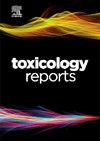裸鼠反复给药后轻度可逆肾毒性
Q1 Environmental Science
引用次数: 0
摘要
Damnacanthal先前被证明是一种有希望的结直肠癌治疗候选药物。它的功效依赖于多次管理。因此,本研究旨在评估20 mg/kg达那坎特尔(DAM20)在3次、7次和14次重复给药后对裸鼠的肾毒性。未见肾毒性临床表现及肾组织病理异常。7次重复剂量DAM20导致BUN下降,尿血清肌酐比升高,尿微量白蛋白漏出(p值分别为0.031、0.016和0.028),提示肾脏和肝脏功能受到扰动。当治疗持续到14次重复剂量时,这些异常中的一些是可逆的。然而,观察到明显的肾脏增大和尿肌酐升高(p值分别为0.032和0.030),提示液体潴留和慢性肾脏疾病。免疫组织化学分析和TUNEL实验一致显示,在3、7和14次重复剂量DAM20的所有小鼠肾组织中,没有cleaved caspase-3表达,DNA片段化,泛巨噬细胞(F4/80)和M2巨噬细胞(CD206)浸润。在14剂量组的一只小鼠中观察到一个例外,它表现出最小的裂解caspase-3激活(0.14 %阳性面积)。然而,在14次重复剂量的DAM20后,肾组织中KIM-1表达显著增加(p- value = 0.012),表明存在肾小管损伤。有趣的是,肾皮质中没有DNA断裂和巨噬细胞浸润,这表明dam20诱导的损伤是轻微的,通过内源性修复机制成功解决,没有进展到不可逆损伤或组织重塑。总之,本研究表明,裸鼠反复给药DAM20可导致轻度可逆肾毒性。然而,需要进一步进行大规模的研究,以更全面地了解达那坎丹的毒性特征,并确保其在潜在治疗应用中的安全使用。本文章由计算机程序翻译,如有差异,请以英文原文为准。
Mild and reversible nephrotoxicity following repeated administration of damnacanthal in nude mice
Damnacanthal was previously shown to be a promising colorectal cancer therapeutic candidate. Its efficacy relied on multiple administrations. This study, therefore, aims to assess the renal toxicity of 20 mg/kg damnacanthal (DAM20) in nude mice following three, seven and 14 repeated administrations. No clinical signs of renal toxicity and abnormal renal tissue histopathology were demonstrated. Seven repeated doses of DAM20 resulted in a decrease in BUN, increased urine-serum creatinine ratio, and urine microalbumin leakage (p-value = 0.031, 0.016 and 0.028, respectively), indicating the perturbation of kidney and liver functions. Some of these abnormalities were reversible to the normal ranges when the treatment continued to 14 repeated doses. However, significant kidney enlargement and increased urine creatinine (p- value = 0.032 and 0.030) were observed, indicating fluid retention and chronic kidney disease. Immunohistochemical analysis and TUNEL assay consistently demonstrated the absence of cleaved caspase-3 expression, DNA fragmentation, and infiltration of pan-macrophages (F4/80) and M2 macrophages (CD206) in the renal tissues of all mice subjected to three, seven, and 14 repeated doses of DAM20. A single exception was observed in one mouse from the 14-dose group, which exhibited minimal cleaved caspase-3 activation (0.14 % positive area). However, a significant increase in KIM-1 expression in renal tissue following 14 repeated doses of DAM20 (p- value = 0.012) indicated the presence of renal tubular injury. Interestingly, the absence of DNA fragmentation and macrophage infiltration in the renal cortex suggests that the DAM20-induced injury was mild, successfully resolved through endogenous repair mechanisms, and did not progress to irreversible damage or tissue remodeling. In conclusion, this study demonstrated that repeated administration of DAM20 in nude mice resulted in mild and reversible nephrotoxicity. However, further large-scale investigations are warranted to gain a more comprehensive understanding of damnacanthal toxicity profile and to ensure its safe use in potential therapeutic applications.
求助全文
通过发布文献求助,成功后即可免费获取论文全文。
去求助
来源期刊

Toxicology Reports
Environmental Science-Health, Toxicology and Mutagenesis
CiteScore
7.60
自引率
0.00%
发文量
228
审稿时长
11 weeks
 求助内容:
求助内容: 应助结果提醒方式:
应助结果提醒方式:


